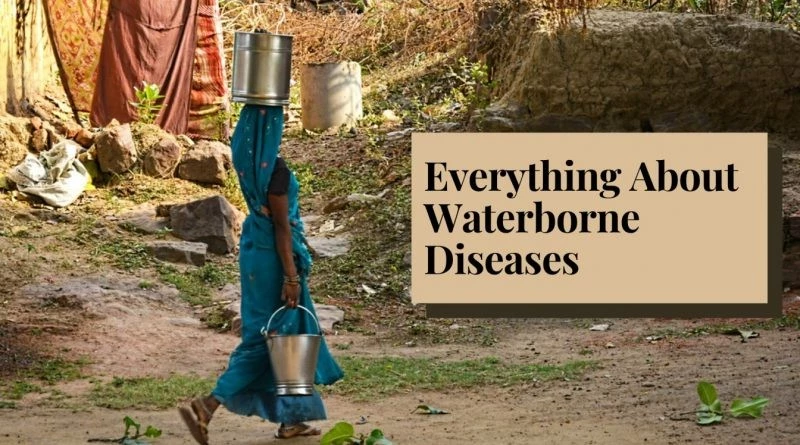Everything About Waterborne Diseases
Table of Contents
Overview
Waterborne diseases are caused by pathogenic microbes spread through contaminated water. Transmission of these pathogens occurs when using infected water for drinking, food preparation, and washing clothes. However, many developing countries don’t have proper water treatment plants, importantly in rural areas.
In some places, the availability of water is so low that people have neither the time nor the money to afford water purifiers or other water treatment systems. Also, most importantly the waterborne diseases around the world mainly affect children due to poor hygiene and weak immunity. Most of these diseases are life-threatening. بلاك جاك 21
What Are Waterborne Diseases
Waterborne disease is any disease caused by drinking water contaminated with human or animal feces, which contains pathogenic microorganisms. The full picture of water-related diseases is complex for several reasons.
Few decades, the scenario of water-related human health issues has become increasingly broad, with the emergence of new water-related infectious diseases and the re-emergence of previously known ones. بينجو اون لاين
The burden of many disease groups can only be partially attributed to water determinants. Even where water plays an important role in the ecology of diseases, it can be difficult to highlight the relative significance of aquatic components to local ecosystems.
About 844 million people do not have even a basic drinking water service. About 159 million individuals depend on surface water, reports the World Health Organization (WHO). According to research, about 2 billion individuals use a source of drinking water that is contaminated with feces. These water sources can transmit water-borne diseases, which are linked to approximately 502,000 diarrheal deaths each year.
Also, read| What is Alzheimer’s Disease: Causes| Symptoms| Stages| Types| Treatment
Symptoms Of Waterborne Diseases
Waterborne diseases can cause a variety of symptoms-
- Diarrhea and vomiting are the most common symptoms of waterborne illness.
- Skin, ear, respiratory.
- Eye problems.
Waterborne Diseases Types and Their Impact
Waterborne disease list-
Diarrhea- The most common of all water-borne diseases list is diarrhea, primarily affecting children under five. Symptoms include dizziness, dehydration, pale skin, and, in severe cases, loss of consciousness. It usually lasts for a few weeks and can be fatal if left untreated.
Cholera- It is mainly caused by a bacteria called Vibrio cholera by consuming contaminated food or drinking water. Symptoms include diarrhea, vomiting, fever, and abdominal cramps. Cholera mainly occurs in children, but it can affect adults as well. It has a mortality rate that is dangerously high in water-borne diseases.
Individuals with weakened immunity, such as those who are malnourished or infected with the human immunodeficiency virus (HIV), are at increased risk of death if they are infected with the bacteria and are more normal to fall under the waterborne disease list.
Giardia- Giardia spread by consuming contaminated water from ponds or rivers, a municipal water supply that is contaminated, and from swimming pools that are not regularly disinfected and is also included in the waterborne diseases list. Symptoms include diarrhea, abdominal pain, abdominal cramps, abdominal bloating, nausea, and weight loss.
Typhoid- Typhoid fever is caused by Salmonella typhi bacteria which is spread through contaminated water. Patients usually suffer from prolonged episodes of fever, loss of appetite, nausea, headache, constipation, and loss of body weight. Immediate attention is needed to cure typhoid in the patient and prevent the spread of this infectious disease.
Amoebiasis- It is caused by a parasite called Entamoeba histolytica. The protozoan organism is spread by inadvertently consuming cysts (an inactive form of the parasite) in food, and it affects the intestine. The parasite thrives on contaminated soil and feces. Common symptoms of amoebiasis include abdominal cramps and watery stools.
Dysentery- This disease-causing microorganism is caused when the spread of, food contaminated with water or feces is consumed. Symptoms include diarrhea, nausea or vomiting, dehydration, blood in the stool, abdominal cramps, and abdominal pain
Hepatitis A- This condition mainly affects the liver and is caused by the hepatitis A virus. The route of contamination is usually oral, while it is also spread through physical contact with an infected person. Hepatitis A patients manifest common symptoms such as fever, nausea, and vomiting, but serious complications can occur if not treated in time.
Transmission Of Waterborne Disease
Climate change plays an important role in the outbreak of such infections which led to disease-causing microorganisms. Major rainfall events such as heavy rain or snowfall increase the risk of water-borne diseases. Many examples of outbreaks of epidemic infections after natural disasters such as floods have been recorded in history.
The overflow of sewage treatment plants during floods becomes an immediate risk that needs to be controlled. Another side, drought-prone areas are also at high risk because of the accumulation of high concentrations of pathogens in the limited amount of available water sources.
Natural disasters like earthquakes or major cyclones create major changes in the ecosystem of water bodies. Often, the newly created environment (pH, temperature, etc.) is favorable for the growth of a particular type of pathogen.
Unprocessed water from such sources becomes harmful for regular use because of the high microbial burden which results in disease-causing microorganisms. The mere carelessness of the sanitation workers especially of water treatment plants can also cause great harm to the community, especially in smaller towns where people do not have water purifiers in their homes.
In addition, frequent use of contaminated water for agricultural purposes (due to lack of pure water in the area) results in the colonization of pathogens in the soil. Consuming crops in that particular area can make residents prone to disease-causing microorganisms.
Precautions To Prevent Waterborne Diseases
- Make sure the water is visibly clean and free of sand and silt. Strain the water to get rid of visible dirt.
- Drink only clean and safe water – either portable water or water filtered through a water purifier. مراهنات
- Regularly service and maintain water purifying equipment like filters, RO units, etc.
- Make sure that the stored water is germ-free.
- Add an antiseptic liquid-like Dettol to the suspicious-looking bathwater.
- Hand hygiene – wash hands regularly with soap after returning home, after using the toilet, before and after preparing food, before eating or drinking anything
- Teach children to hand hygiene. Children should make it a habit to always wash their hands when they return home after playing sports.
- Make sure the food is thoroughly washed and cooked.
- Whenever possible, use disposable glasses and plates when eating outside food, especially after street food.
- Avoid eating stale cooked food, keep unrefrigerated food outside open for a long time.
- Get vaccinated against preventable diseases like typhoid, hepatitis A, polio, etc.
Treatment Of Waterborne Diseases
Treatment of waterborne diseases includes affected individuals use, antibacterial, parasitic, or antiviral drugs are used for treatment, depending on the nature of the disease. However, simple precautions to keep the surroundings clean can do wonders to stop the spread of these diseases. Additionally, maintaining personal hygiene dramatically reduces the incidence of water-borne diseases.
Prevention Of Waterborne Diseases
It should be ensured that their drinking water is filtered and purified. Also, the water used for cooking at home should be equally pure. Being aware and aware of the surroundings, avoiding street food (especially if the cooking area is dirty in appearance), and covering and storing food safely at home are some basic tips to prevent such diseases.
The governments of countries with a high incidence of water-borne diseases often conduct health screening and awareness campaigns. They educate and sensitize communities about risks and common precautions. Avoiding waterlogging (such as from rain) around homes is an important step in preventing water-borne diseases.
In addition to precautions at the individual level, several other approaches are employed to control water-borne diseases, including large-scale recycling of water and carbon sequestration. Protecting natural water sources and land is another important strategy to combat climate change.
Effective irrigation techniques have been developed by agricultural scientists for optimum utilization of water during cultivation. The creation of “green space” and responsible use of natural resources is at the core of sustenance to prevent water-borne diseases.
FAQ’s Related To Water Borne Diseases
What is the most common water-borne disease?
Out of the seven most common waterborne diseases in the world, diarrhea is the main symptom and the worst problem due to water-borne disease. The latest research shows that diarrhea is the second leading cause of death for children under the age of five, creating more childhood deaths than malaria, AIDS, and measles.
What are the diseases caused by water?
Diseases such as-
- Cholera
- Diarrhea
- Dysentery
- Hepatitis A
- Typhoid
- Polio
What are the water-borne diseases in India?
Waterborne diseases like cholera, acute diarrhea, typhoid, and viral hepatitis are prevalent in India and have caused 10,738 deaths in the last five years since 2017. From these, acute diarrheal diseases have the highest number of deaths due to viral hepatitis, typhoid, and cholera.
What are the 10 sources of water?
- Surface Water Resources
- Groundwater Resources
- Stormwater Resources
- Wastewater Resources
- Saltwater Resources
- Ice Cap Water Resources
What is the prevention of water-borne diseases?
Measures to prevent water-borne diseases-
- Drink only filtered/boiled water.
- Store water in a clean vessel.
- Water jars/containers should be washed daily.
- Always wash hands before and after preparing or eating food, similarly, children should be taught to wash their hands.
Can water cause bacterial infections?
The bacterial infection commonly causes diarrhea, abdominal cramps, vomiting, and fever. Symptoms of the virus include fatigue, fever, vomiting, headache, muscle aches, and cramps. Chronic infection can occur when a person continues to drink contaminated water.
How are water-borne diseases spread?
Waterborne diseases are conditions caused by pathogenic micro-organisms that spread through water. These diseases can be spread by bathing, washing, drinking water, or eating food by coming in contact with contaminated water.
What is the difference between waterborne and water-washed diseases?
Water-based diseases are caused due to parasites that spend a part of their life cycle in water. Water-based diseases like bilharzia (also called schistosomiasis – this will be described in section 2.3.3), and dracunculiasis caused by helminths.



